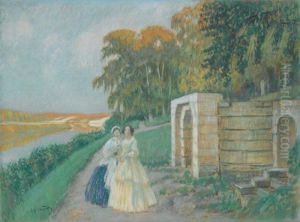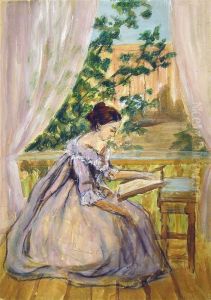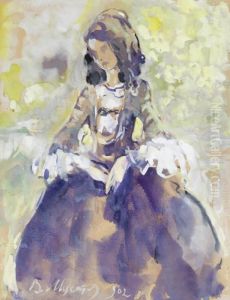Victor Borissow-Mussatow Paintings
Victor Elpidiforovich Borisov-Musatov was a Russian painter associated with the Symbolist movement, known for his distinctive style that fused elements of Realism, Romanticism, and Impressionism with a dream-like atmosphere. Born on April 2 (14), 1870, in Saratov, Russia, into a family with French roots, Borisov-Musatov developed an early interest in the arts, influenced by the rich cultural environment of his family.
Borisov-Musatov's initial art education began at the Saratov Art School, where he showed promise. However, his artistic journey was not without challenges. At the age of 16, he suffered a fall that resulted in a spinal injury, causing a lifelong disability that would affect his mobility and health. Despite this setback, he continued to pursue his passion for art and in 1890 moved to Moscow to study at the Moscow School of Painting, Sculpture and Architecture. There, he was under the tutelage of notable artists such as Viktor Vasnetsov and Valentin Serov.
His education was furthered abroad when, in 1895, Borisov-Musatov went to Paris to attend the Académie Colarossi. During his time in France, he was exposed to the works of the Impressionists and Symbolists, which left a lasting impact on his style. He was particularly influenced by the art of Puvis de Chavannes, whose ethereal and allegorical works resonated with Borisov-Musatov's own sensibilities. The artist also developed an appreciation for the soft, diffused light and the nostalgic qualities found in the paintings of the French Symbolists.
After returning to Russia in 1898, Borisov-Musatov settled in the ancient city of Tarusa, where he became a central figure in the Russian Symbolist movement. His works from this period are characterized by a sense of serene stillness and a focus on the beauty of the Russian landscape and its historic estates. He often depicted scenes of leisure, featuring elegantly dressed women in idyllic garden settings, as seen in his notable works 'The Pool' (1902) and 'The Phantoms' (1903). These paintings reflect his contemplative nature and his desire to express a sense of harmony and timeless beauty.
Borisov-Musatov's oeuvre is marked by a poetic and introspective quality, with a palette often dominated by soft, muted tones. His compositions are imbued with a sense of melancholy and longing for the past, which was a common theme among Symbolists. His works are also notable for their subtle integration of figures with their surroundings, creating a unified, dream-like atmosphere.
Tragically, Borisov-Musatov's career was cut short when he died on October 26 (November 8), 1905, at the age of 35, in Tarusa. Despite his brief life, he left behind a body of work that has had a lasting impact on Russian art. Borisov-Musatov's paintings are now highly regarded and can be found in prestigious collections, including the Tretyakov Gallery in Moscow and the Russian Museum in St. Petersburg. His unique blend of styles and his contribution to the Symbolist movement continue to be celebrated for their beauty and emotional depth.


